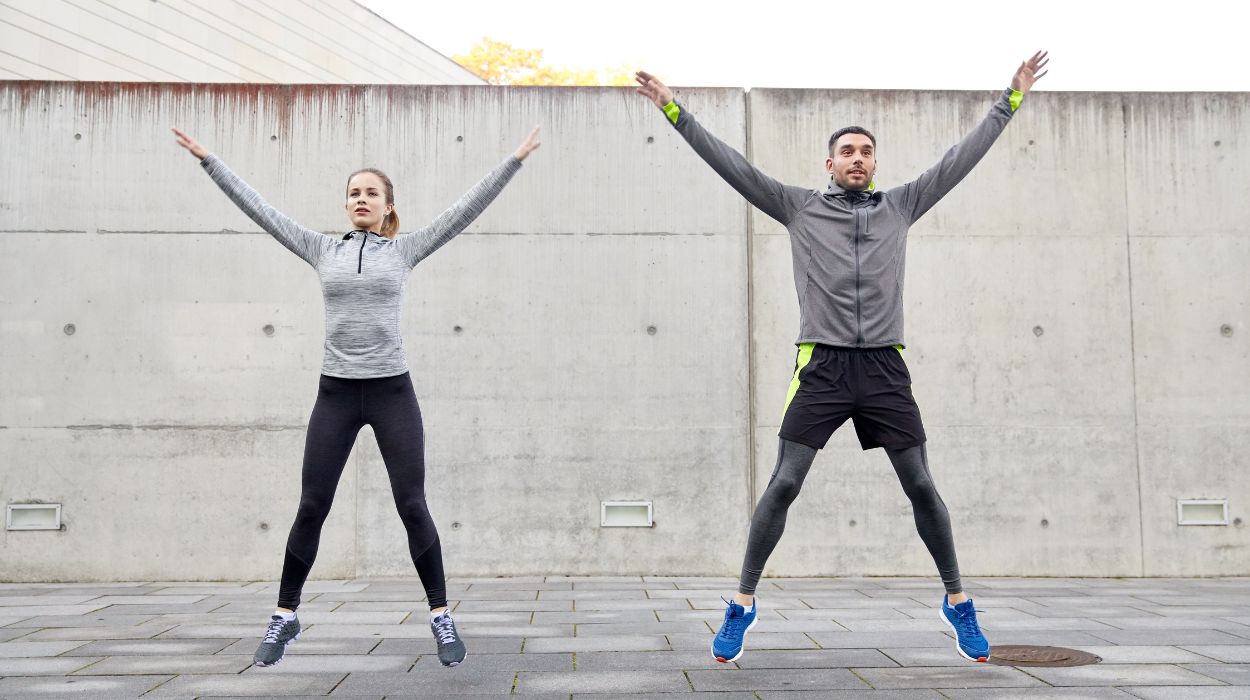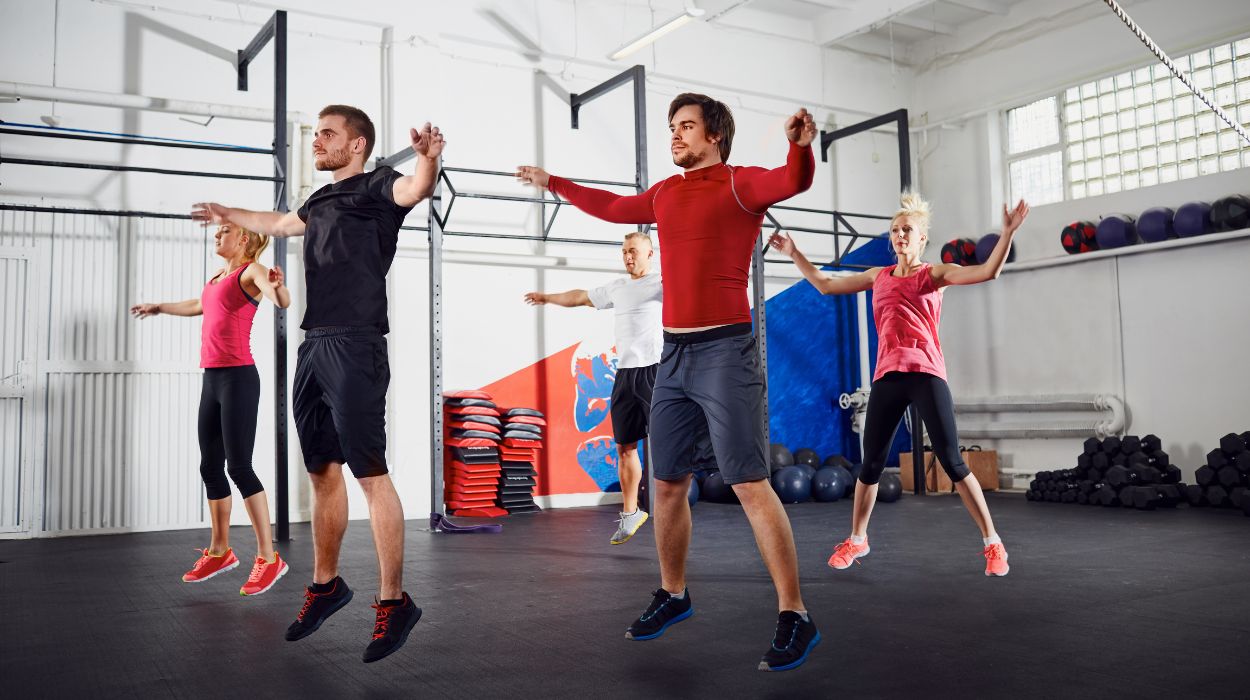Jumping jacks are a popular bodyweight exercise. As the name suggests, this straightforward movement is performed by hopping your feet out to the side and back in while raising your arms up and down.
You won’t need to look far to see this exercise included in various exercise programs; it is a key feature in tabata or HIIT workouts. Jumping jacks are an effective bodyweight movement amongst home workout programs. These associated traits may cause some individuals to wonder how many jumping jacks a day to lose weight.
Read on to learn more and see how to lose weight fast.
Is Jumping Jacks A Good Way To Lose Weight?
Jumping jacks can effectively contribute to weight loss.
Some benefits of jumping jacks include:
- Increase fitness level.
- Improved body composition.
- Increase in lower body strength.
- Increased bone density.
- Promotes fat loss.
- Contributes to a calorie deficit.
How Many Jumping Jacks Should You Do A Day To Lose Weight?
When asking how many jumping jacks to lose weight, it is important to consider many variables. To lose weight, consider physical activity, food intake, diet quality, adequate sleep, and stress levels.
Caloric Deficit
The exact amount of jumping jacks required to lose weight will depend on many factors relating to the individual. One consideration is the amount of calories they burn when performing the exercise. But first, one must determine the calories needed to achieve a calorie deficit.
Ultimately, successful weight loss is attributed to maintaining a negative energy balance.[1] Put simply, energy balance is the combination of energy input and energy output.
To achieve a negative energy balance, commonly referred to as a calorie deficit, you can reduce your food intake, increase your activity level, or combine both, which may also feel more sustainable.
Diet
While energy balance is crucial, diet quality is another significant factor in weight loss. A healthy diet is recommended for general health and well-being and encouraged to aid in weight loss and maintenance.
While it could feel tempting to reach for what seems like faster methods, such as diet pills, it’s recommended to establish a healthy eating pattern first rather than seeking supplements.
A balanced diet should include the recommended daily fruit, vegetables, lean proteins, healthy fats, and whole grains intake. Following this diet will ensure that you also get enough dietary fiber.[2] Dietary fiber is another essential factor that positively contributes to overall health and body weight.
Additionally, it’s essential to limit and reduce processed and junk food as much as possible. A proper diet supports weight and fat loss and positively impacts vital health markers such as blood pressure.[3] If you’re still struggling with losing extra fat having made many lifestyle changes, consider using a fat burner to support your weight loss efforts.
Sleep And Stress
Finally, weight loss also relies on sleep quality and quantity and keeping stress levels to a minimum. To support optimal health, adults achieve seven to nine hours of sleep;[4] This recommendation is also important for a healthy body weight. Furthermore, high stress levels can negatively impact body weight, and therefore you can consider adopting stress management techniques if this applies to you.
As you can see, there are many factors outside of physical activity that contribute to weight loss. Understanding your weight holistically and taking a well-rounded approach to losing weight will be the most effective. With this in mind, let’s focus on a popular physical activity: jumping jacks.
What Are Jumping Jacks?

Jumping jacks are an effective cardio exercise that’s considered a high-intensity activity. Performing jumping jacks can positively contribute to overall activity levels and effectively impact cardiovascular fitness. This exercise is commonly featured as a warm-up before more challenging exercises.
Jumping jacks are a stable exercise in many high-intensity workouts, likely due to their ability to be performed practically anywhere. Furthermore, the fact that they are effective full-body exercises could also contribute to their popularity. The exercise is simply a continuous pattern of jumping your feet out to the sides and back in.
It is worth noting that jumping exercises are high-impact,[5] meaning they place more stress and strain on bones. While this can be beneficial in improving both strength and bone density, high-impact exercises can be unsuitable for some due to increased stress on the bones and joints.
However, the good news is that you can easily modify jumping jacks to suit your needs. Instead of jumping, you can simply step side to side, mimicking the motions of a full jumping jack without the high stress on the joints. Also referred to as a star jump, this simple movement has undoubtedly become popular due to its adaptability and versatility.
How Many Calories Do Jumping Jacks Burn?
According to the CDC,[6] jumping jacks are considered a vigorous activity. When considering an individual’s average weight, which is 70 kg or 154 lbs, according to the CDC guidelines, jumping jacks could burn about seven calories per minute.
This, of course, is estimated based on the vigorous intensity level and average weight stated. To achieve vigorous intensity, your target heart rate needs to be between 77% to 93%[7] of your maximum heart rate. Maximum heart rate is determined by subtracting your age from 220.
Given this information, individual calorie burn can be influenced by factors such as body weight, intensity level and duration. Nonetheless, this provides an approximate number of what you can expect.
If you are wondering how many jumping jacks I should do to help with weight loss, utilize the above information. Using the seven calories above, 70 calories would be burnt on average if performed for 10 minutes. However, the exact calorie count depends on the speed and intensity of your jumping jacks, such as whether you are doing 100 or 500 in a short or long period of time.
To get started, try setting a daily goal of 100 jumping jacks. Additionally, a calorie calculator can help determine your potential calorie burn based on your weight, intensity and duration achieved.
Benefits Of Jumping Jack Exercises
Positive benefits can be elicited from working at high intensities. Improvements have been displayed[8] in insulin sensitivity, fitness level, cardiovascular health, and body composition. Working at high intensities, usually nearing maximal rate, can elicit the most significant results.
Incorporating jumping jacks into your full-body workout can provide many benefits, if performed regularly at an adequate intensity and duration. However, regardless of specific details, some benefits you can expect include:
- Improved cardiovascular fitness.
- Increase bone density[9] and bone strength.
- Improved lower body strength.[10]
- Improved insulin levels.
- Improved body composition.
Further benefits of jumping jacks include:
- Easy to modify, adapt, and scale to individual levels.
- Provides an accessible aerobic exercise that can be performed anywhere.
- Time efficient if incorporated in a Tabata or HIIT style workout.
- A full-body cardio workout that can burn calories without needing equipment.
- Can be used as a warm-up exercise to increase body temperature, heart rate, and blood flow.
- Encourage and increase exercise adherence due to the ability to perform at home.
How To Do Jumping Jacks

Before performing jumping jacks, it’s essential to ensure you have a clear space to move freely around you. Another consideration is ensuring you are on a flat, stable surface. Besides these factors, jumping jacks do not require much space as they can be performed in a small area that allows your arms to fully extend and you to jump freely in the same spot.
To perform jumping jacks,[11] place your feet hip-width apart and arms by your sides; this is the starting position. Initiate the movement by jumping both feet out sideways while simultaneously raising your arms to shoulder height or overhead. Jump back to the starting position while bringing your arms back down to your sides. Finally, repeat for the specific length of time or number of repetitions.
Conclusion
Jumping jacks are an effective, full-body cardiovascular exercise that can be seamlessly incorporated into any exercise routine. Their ease of access makes them an excellent option for individuals, regardless of fitness level or ability. In addition, consider these effective workouts for weight loss outcomes.
Many physical and mental benefits can be attributed to this versatile movement. The accessibility factor of this exercise can help increase the frequency of exercise performed due to its convenience. The ability to be performed in a small space without equipment further highlights the accessible and low-cost nature.
Jumping jacks can improve the body’s ability in various physical aspects, including cardiovascular fitness and lower body strength. Their adaptability allows for regression or progression of the movement, too, enabling you to continue burning calories appropriately.
Finally, performing 500 jumping jacks a day results could be significant; however, you don’t necessarily need to go to that extent to experience positive benefits. Incorporating jumping jacks into your interval training or daily exercise can contribute to calorie burn, fat loss and increased fitness, while building the strength in more muscles than those mainly used in a jumping jack.
Frequently Asked Questions
Jumping jacks are an effective exercise that can be included in high-intensity interval training. Performing jumping jacks can burn calories, build muscle, and promote fat loss. These factors can contribute to reduced body and belly fat.
While specific exercise targets can help, successful weight loss outcomes rely on factors such as maintaining a calorie deficit, engaging in regular exercise, ensuring adequate sleep and maintaining stress levels.
Based on an average body weight of 150 lbs, jumping jacks could burn 7 calories or more per minute. From this, 10 minutes would burn approximately 70 calories; 15 minutes would burn about 105 calories.
The amount of calories burnt depends on factors such as exercise intensity, duration and body weight. Full body movements performed at a high intensity will generally burn the most calories.
 Evidence Based
Evidence Based
